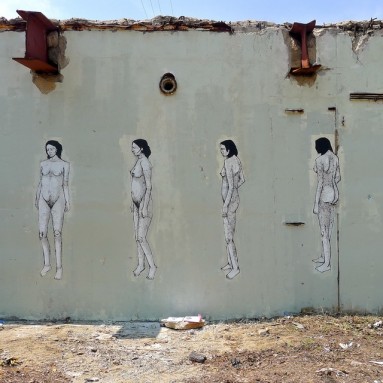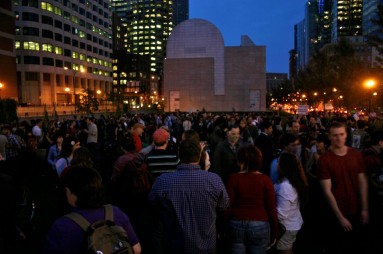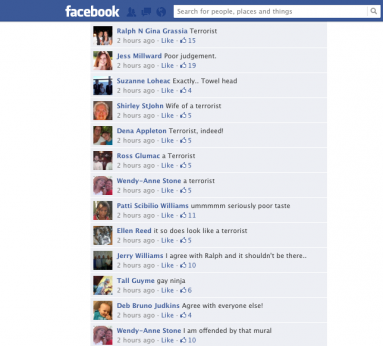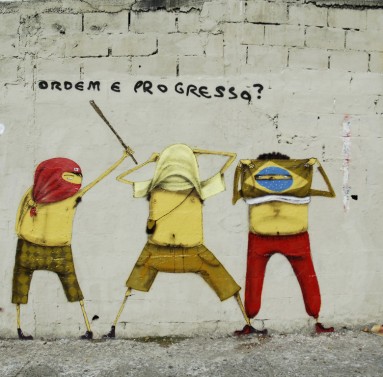Boston is a city perennially self-conscious about public art. A recent Boston Phoenix cover story examined why so many young artists leave a city ranked in the Top 10 for national arts funding. When it comes to large-scale works in the public domain the city tends to favor exogenous creations rather than home-grown communities that shape or foster artistic breakthroughs. The accusation that the city is risk-averse and WASP-y descends from an 'age-old attitude central to the very culture of Boston itself: a city where philanthropy as historically been dedicated to institutions and fine art, rather than to visual art and artists that push boundaries.'¹
The most publicly discussed art work to happen to the city this year, or at least as long as anyone can remember, is 'The Giant of Boston' by Os Gêmeos. Otávio and Gustavo Pandolfo are Brazilian brothers from São Paulo who co-produce all of their sanctioned and illicit pieces as 'the twins.' They sign their entire jointly-bred oeuvre as a single artist. Os Gêmeos' local work is comprised of three murals around the city and a Fall 2012 exhibition at the Institute of Contemporary Art, the most prominent artistic institution in Boston. The story of how the brothers' first major solo showcases in the United States came to be localized in the city reveals very little about Boston's conservative art fixtures themselves. After all, the commissioned works by the artists were generously funded by several senior, prestigious institutions. The twins are internationally hailed (their presence has been described as 'kind of like the Rolling Stones coming and giving a free concert on the Greenway'²), thus less 'controversial' choices in and of themselves even though they originate from—heaven forbid—a Latin American nation.
Despite the great care taken to select bonafide art stars and avoid anything 'overtly political' (as curator Pedro Alonzo commented) the Dewey Square mural has managed to spark a ripple of trouble. The general story unfolds like this: Fox News posed the mural as a question to its viewers and in doing so fabricated a not-so-minor controversy. 'This is a new mural on a Big Dig ventilation building. What does it look like to you?' Fox encouraged their viewers to air their thoughts on the station's Facebook page. That thread has since been removed, but not before several screengrabs were taken of spectators explicitly likening the mural subject to a terrorist.
The bright yellow, head-wrapped figure in the mural was interpreted by Bostonians as an Al Qaeda operative, Bart Simpson disguised as a mujahideen fighter, the wife of a terrorist, a 'towel head Islamist holding a gun,' an 'allah [sic] loving united states hating individual,' a 'gay ninja,' a Taliban fighter, and 'a tribute to [President Barack] Obama's birthday.' Lest it be said that these comments were cherry-picked, Metro Boston reported that the post spawned more than 600 racially centered or bigoted comments.
Perhaps the most honest and frank exchange about the mural (from Fox's 'Greenway mural interpreted as little boy, terrorist') took place between between a child and a reporter.
Child: It's scary like a Batman.
Reporter: Why is it scary?
Child: Because it has something covered. And its nose is covered with a blanket.
I want to make room for at least two arguments: first, that the 'controversy' surrounding the figure in the mural should not be dismissed just because it appears wholesale-manufactured by a Fox News station. An op-ed by the ICA's current director Jill Medvedow ('The Art of Controversy,' 25 September 2012) claimed that 'the critical issue raised by Os Gemeos’ mural is not an aesthetic one; rather I believe it is an issue of the media declaring a controversy, rather than reporting on one.' By default that argument dismisses the politics of aesthetic life and artistic choices (curiously so, for artists whose work has been politically charged since its inception on the streets), and whether or not Medvedow intends to, the statement diminishes the value of the work as anything more than a brightening rejuvenation of the drab downtown financial district.
Second, and more importantly, while a visible part of that controversy is playing itself out (namely between the art institution backing it and detractors) the unseen/unseeable and unspoken/unsayable relationship between the art work and its spatial site must be a part of the discussion the city is having.
By consensual popular assembly, Dewey Square was chosen as the site of the Occupy Boston (OB) encampment in autumn 2011. OB never sought explicit 'permission' to occupy the wide patch of grass (in the shadow of the U.S. Federal Reserve) from the private proprietors of Dewey Square, the Rose Fitzgerald Kennedy Greenway Conservancy. In October 2011, on the heels of police warnings of a first raid, the Rose Kennedy issued a statement saying, 'No one asked for permission. No one gave permission.' That initial non-participation, which later got rescinded, was viewed as an implicit go-ahead while encampment was still a part of OB's main tactic.
The mural in Dewey Square (I am not discussing the smaller mural at the luxury boutique Revere Hotel—formerly the Charles Street jail—or the collaborative mural with RYZE, Todd James, and Caleb Neelon in Union Square) was granted explicit permission. In addition to the private funding that afforded its creation, cooperation between the Massachusetts Department of Transportation, the Boston Art Commission, and the City of Boston 'allow[ed] the use of the ventilation building wall' and proper permitting.
What Boston is certainly not having is a discussion about what public discourses (and I use discourse in a more basic sense than the Foucauldian understanding to mean a space of examination and scrutiny about sociopolitical participation, inclusion, and access) are allowable, seeable, and sayable. A counter-argument might defend the poor patches of grass and shrubbery the Conservancy cited in its protectionist pamphlets during the OB debacle, but it is clear that the city veritably bended backward to approve this privately funded art work and didn't let ventilation issues get in the way. One might also say that art is politically innocuous (and the ICA director implied as much in declaring the mural a manufactured non-controversy), which is fine, but that's not a discussion I want to be a part of. We're talking about a space in which people were beaten and forcefully expelled that now boasts an art piece from one of the most celebrated muralists in the world.
So far I've thought about the meaning the art work has engendered in its current location, but not the work itself. In truth (and I say this after having admired their works both in museums and on the giant walls of the Teatro Municipal in São Paulo) I am somewhat conflicted, maybe out of an inability or refusal to divorce it from what happened at Dewey. The Pandolfo brothers have declined (perhaps wisely) to discuss it other than to say they believe in 'peace' and 'imagination.' To me, the crouching, face-covered yellow boy epitomizes the seedling of dissent and in that sense the mural seems to 'speak' (though its mouth is obfuscated) for itself, whether or not the artists directly address the fact that the repression brought to bear on Dewey Square has been resignified by his presence.
But the question of the semiotic effect of the masked figure remains, and that is what aroused the ire of more than 600 commenters (and at least one young Batman-fearing boy) when they described the little Giant of Boston as a terrorist. The effect differs not only transregionally (the brothers have painted several murals but this is the first in the US) but also transculturally. What does the covered face of a lone figure mean in Brazil versus Boston? Or that this specific figure has become the subject of an American mural as opposed to other very recent Os Gêmeos creations, such as their collaborative work with Aryz in Lodz, Poland?
Locally, Mayor Thomas Menino infamously railed a year ago that he would 'not tolerate civil disobedience in the city of Boston' ('Occupy Boston: The People and the Land,' 11 October 2011). The word 'anarchist' was once again thrown in as a hooliganist word to encode lawlessness, mayhem, and general disarray rather than the mutual aid-based meaning among anarchists themselves. One doesn't have to begin by looking toward political activists (of all ethnic and class backgrounds) since Seattle 1999 to consider the effect of covered faces in the U.S. And beyond the use of covering for Islamic religious observance, covering one's head or face arouses great suspicion. Think of Trayvon Martin in his 'street' clothes. The paranoia of surveillance systems that demand the right to biometric visibility is beyond my purview here, but for a quick cartography see the ACLU's 'Surveillance cameras eye Occupy Boston' map.
In Brazil face coverage highlights two things: the importance of not being identified (in a police/media alliance where arrestees are widely filmed and photographed, their images distributed as mug shots before so much as a charge) and a way to draw attention to the invisibility of the poor. This is not a matter of inference: Os Gêmeos have explicitly questioned the Brazilian flag's motto (drawn from French positivist Auguste Comte) of 'order and progress' in their art. Their yellow, sometimes brown figures in tattered clothes and covered faces serve as inconvenient thorns to that civilizational project.
The issue of visibility in the public sphere in a contemporaneous discussion about art in the age of political desuetude is greater than this one instance, but that is what leaves me torn about it. Occupy (I don't mean the tactic or the movement but the larger attitude it ushered) is still 'sayable' in that it is widely discussed, my personal distaste or disinterest for 'anniversaries' just one year later aside. But it has become barely seeable if judged by the direct, systematic repression of every last encampment site in the country ('Democratic leaders and OWS crackdowns'). The gaze of the quiet giant above Dewey, despite the weak claims of establishments that defend its presence on the grounds of 'Because ART!' is a visual and spatial reminder of all this.
By way of a footnote about another city whose movements I follow: Japanese artist Hyuro's mural in Atlanta, based on her animation 'Layers' (2011) of the same name, was removed on the heels of the Os Gêmeos mural going up. (The Huffington Post called it a 'dog dress.') The objection raised was the nude nature of Hyuro's figure. Its absence is an assurance that not even art is a safe space despite such claims in the chronicles liberal permissiveness.





